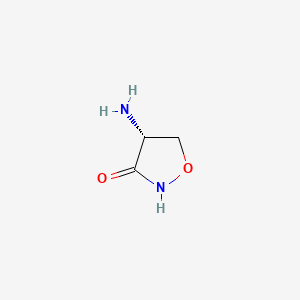| MeSH term | MeSH ID | Detail |
|---|---|---|
| Starvation | D013217 | 47 associated lipids |
| Tuberculosis, Multidrug-Resistant | D018088 | 6 associated lipids |
D-cycloserine
D-cycloserine is a lipid of Polyketides (PK) class. D-cycloserine is associated with abnormalities such as Inflammatory disorder, Asthma, Rheumatoid Arthritis, Multiple Sclerosis and Inflammatory Bowel Diseases. The involved functions are known as Cellular Infiltration, Vascular Permeability, Stimulus, antagonists and Kinase Inhibitors [MoA]. D-cycloserine often locates in Tissue membrane, Body tissue, Protoplasm, Endothelium and Cell Wall. The associated genes with D-cycloserine are Genome, serine O-sulfate, Polypeptides, alpha-aminobutyric acid, (S)-isomer and Genes, Reporter. The related lipids are Sphingolipids, Fatty Acids, Sterols, 25-hydroxycholesterol and Fatty Acids, Unsaturated.
Cross Reference
Introduction
To understand associated biological information of D-cycloserine, we collected biological information of abnormalities, associated pathways, cellular/molecular locations, biological functions, related genes/proteins, lipids and common seen animal/experimental models with organized paragraphs from literatures.
What diseases are associated with D-cycloserine?
D-cycloserine is suspected in Tuberculosis, Inflammatory disorder, Asthma, Rheumatoid Arthritis, Multiple Sclerosis, Inflammatory Bowel Diseases and other diseases in descending order of the highest number of associated sentences.
Related references are mostly published in these journals:
| Disease | Cross reference | Weighted score | Related literature |
|---|
Possible diseases from mapped MeSH terms on references
We collected disease MeSH terms mapped to the references associated with D-cycloserine
PubChem Associated disorders and diseases
What pathways are associated with D-cycloserine
There are no associated biomedical information in the current reference collection.
PubChem Biomolecular Interactions and Pathways
Link to PubChem Biomolecular Interactions and PathwaysWhat cellular locations are associated with D-cycloserine?
Visualization in cellular structure
Associated locations are in red color. Not associated locations are in black.
Related references are published most in these journals:
| Location | Cross reference | Weighted score | Related literatures |
|---|
What functions are associated with D-cycloserine?
Related references are published most in these journals:
| Function | Cross reference | Weighted score | Related literatures |
|---|
What lipids are associated with D-cycloserine?
Related references are published most in these journals:
| Lipid concept | Cross reference | Weighted score | Related literatures |
|---|
What genes are associated with D-cycloserine?
Related references are published most in these journals:
| Gene | Cross reference | Weighted score | Related literatures |
|---|
What common seen animal models are associated with D-cycloserine?
There are no associated biomedical information in the current reference collection.
NCBI Entrez Crosslinks
All references with D-cycloserine
Download all related citations| Authors | Title | Published | Journal | PubMed Link |
|---|---|---|---|---|
| Na ES et al. | D-cycloserine improves synaptic transmission in an animal mode of Rett syndrome. | 2017 | PLoS ONE | pmid:28813484 |
| Bürkner PC et al. | D-cycloserine augmentation of behavior therapy for anxiety and obsessive-compulsive disorders: A meta-analysis. | 2017 | PLoS ONE | pmid:28282427 |
| Mao Z et al. | A simplified LC-MS/MS method for rapid determination of cycloserine in small-volume human plasma using protein precipitation coupled with dilution techniques to overcome matrix effects and its application to a pharmacokinetic study. | 2017 | Anal Bioanal Chem | pmid:28224247 |
| Sogebi OA et al. | Clinical predictors of aminoglycoside-induced ototoxicity in drug-resistant Tuberculosis patients on intensive therapy. | 2017 | Auris Nasus Larynx | pmid:27832910 |
| Choi JH et al. | [Concomitant Drug Reaction with Eosinophilia and Systemic Symptom Syndrome from Ethambutol and Autoimmune Hepatitis from Isoniazid]. | 2016 | Korean J Gastroenterol | pmid:27206439 |
| Norrholm SD et al. | Baseline psychophysiological and cortisol reactivity as a predictor of PTSD treatment outcome in virtual reality exposure therapy. | 2016 | Behav Res Ther | pmid:27183343 |
| Meuret AE et al. | The desire to belong: Social identification as a predictor of treatment outcome in social anxiety disorder. | 2016 | Behav Res Ther | pmid:27070526 |
| Eniyan K et al. | Development of a one-pot assay for screening and identification of Mur pathway inhibitors in Mycobacterium tuberculosis. | 2016 | Sci Rep | pmid:27734910 |
| Sartori SB et al. | Combined Neuropeptide S and D-Cycloserine Augmentation Prevents the Return of Fear in Extinction-Impaired Rodents: Advantage of Dual versus Single Drug Approaches. | 2016 | Int. J. Neuropsychopharmacol. | pmid:26625894 |
| Malan-Müller S et al. | Molecular mechanisms of D-cycloserine in facilitating fear extinction: insights from RNAseq. | 2016 | Metab Brain Dis | pmid:26400817 |
